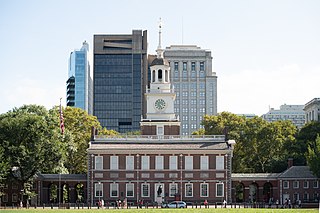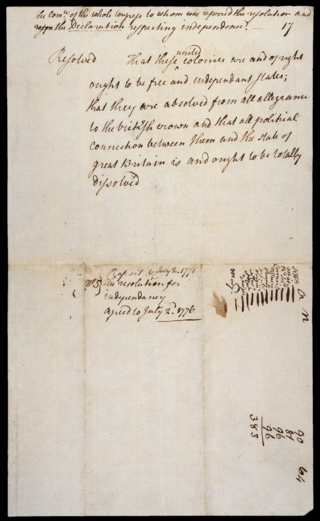
The Declaration of Independence, formally titled The unanimous Declaration of the thirteen united States of America, is the founding document of the United States. On July 4, 1776, it was adopted unanimously by the 56 delegates to the Second Continental Congress, who had convened at the Pennsylvania State House, later renamed Independence Hall, in the colonial era capital of Philadelphia. The declaration explains to the world why the Thirteen Colonies regarded themselves as independent sovereign states no longer subject to British colonial rule.

The Thirteen Colonies were a group of British colonies on the Atlantic coast of North America during the 17th and 18th centuries. Grievances against the imperial government led the 13 colonies to begin uniting in 1774, and expelling British officials by 1775. Assembled at the Second Continental Congress in Philadelphia, they appointed George Washington as commander-in-chief of the Continental Army to fight the American Revolutionary War. In 1776, Congress adopted the Declaration of Independence as the United States of America. Defeating British armies with French help, the Thirteen Colonies gained sovereignty with the Treaty of Paris in 1783.

The Continental Congress was a series of legislative bodies, with some executive function, for the Thirteen Colonies of Great Britain in North America, and the newly declared United States before, during, and after the American Revolutionary War. The Continental Congress refers to both the First and Second Congresses of 1774–1781 and at the time, also described the Congress of the Confederation of 1781–1789. The Confederation Congress operated as the first federal government until being replaced following ratification of the U.S. Constitution. Until 1785, the Congress met predominantly at what is today Independence Hall in Philadelphia, though it was relocated temporarily on several occasions during the Revolutionary War and the fall of Philadelphia.

Benjamin Harrison V was an American planter, merchant, and politician who served as a legislator in colonial Virginia, following his namesakes' tradition of public service. He was a signer of the Continental Association, as well as the United States Declaration of Independence, and was one of the nation's Founding Fathers. He served as Virginia's governor from 1781 to 1784.

Benjamin Chew was a fifth-generation American, a Quaker-born legal scholar, prominent and successful Philadelphia lawyer, slaveowner, and chief justice of the Supreme Court of the Province of Pennsylvania and later the Commonwealth of Pennsylvania. Chew was known for precision and brevity in his legal arguments and his excellent memory, judgment, and knowledge of statutory law. His primary allegiance was to the supremacy of law and the constitution.

Independence Hall is a historic civic building in Philadelphia, where both the United States Declaration of Independence and the United States Constitution were debated and adopted by America's Founding Fathers. The structure forms the centerpiece of the Independence National Historical Park and was designated a World Heritage Site in 1979.

The Pennsylvania Constitution of 1776 was the state's first constitution following its declaration of independence and has been described as the most democratic in America. It was drafted by Robert Whitehill, Timothy Matlack, Dr. Thomas Young, George Bryan, James Cannon, and Benjamin Franklin. Pennsylvania's innovative and highly democratic government structure, featuring a unicameral legislature and collective executive, may have influenced the later French Republic's formation under the French Constitution of 1793. The constitution also included a declaration of rights that coincided with the Virginia Declaration of Rights of 1776.

The Province of Pennsylvania, also known as the Pennsylvania Colony, was a British North American colony founded by William Penn, who received the land through a grant from Charles II of England in 1681. The name Pennsylvania was derived from "Penn's Woods", referring to William Penn's father Admiral Sir William Penn.

The Sons of Liberty was a loosely organized, clandestine, sometimes violent, political organization active in the Thirteen American Colonies founded to advance the rights of the colonists and to fight taxation by the British government. It played a major role in most colonies in battling the Stamp Act in 1765 and throughout the entire period of the American Revolution. Historian David C. Rapoport called the activities of the Sons of Liberty "mob terror."

John Dickinson, a Founding Father of the United States, was an attorney and politician from Philadelphia, Pennsylvania, and Wilmington, Delaware. Dickinson was known as the "Penman of the Revolution" for his twelve Letters from a Farmer in Pennsylvania, published individually in 1767 and 1768, and he also wrote "The Liberty Song" in 1768.

The Founding Fathers of the United States, commonly referred to as the Founding Fathers, were a group of late-18th-century American revolutionary leaders who united the Thirteen Colonies, oversaw the War of Independence from Great Britain, established the United States of America, and crafted a framework of government for the new nation.

The committees of correspondence were a collection of American political organizations that sought to coordinate opposition to British Parliament and, later, support for American independence during the American Revolution. The brainchild of Samuel Adams, a Patriot from Boston, the committees sought to establish, through the writing of letters, an underground network of communication among Patriot leaders in the Thirteen Colonies. The committees were instrumental in setting up the First Continental Congress, which convened in Philadelphia in September and October 1774.

The Lee Resolution, also known as "The Resolution for Independence", was the formal assertion passed by the Second Continental Congress on July 2, 1776, which resolved that the Thirteen Colonies, then referred to as the United Colonies, were "free and independent States" and separate from the British Empire, which created what became the United States. News of this act was published that evening in The Pennsylvania Evening Post and the next day in The Pennsylvania Gazette. The Declaration of Independence, which officially announced and explained the case for independence, was approved two days later, on July 4, 1776.

Independence National Historical Park is a federally protected historic district in Philadelphia, Pennsylvania that preserves several sites associated with the American Revolution and the nation's founding history. Administered by the National Park Service, the 55-acre (22 ha) park comprises many of Philadelphia's most-visited historic sites within the Old City and Society Hill neighborhoods. The park has been nicknamed "America's most historic square mile" because of its abundance of historic landmarks.

Pennsylvania was the site of many key events associated with the American Revolution and American Revolutionary War. The city of Philadelphia, then capital of the Thirteen Colonies and the largest city in the colonies, was a gathering place for the Founding Fathers who discussed, debated, developed, and ultimately implemented many of the acts, including signing the Declaration of Independence, that inspired and launched the revolution and the quest for independence from the British Empire.

The Committee of Five of the Second Continental Congress was a group of five members who drafted and presented to the full Congress in Pennsylvania State House what would become the United States Declaration of Independence of July 4, 1776. This Declaration committee operated from June 11, 1776, until July 5, 1776, the day on which the Declaration was published.

Declaration of Independence is a 12-by-18-foot oil-on-canvas painting by the American artist John Trumbull depicting the presentation of the draft of the Declaration of Independence to Congress. It was based on a much smaller version of the same scene, presently held by the Yale University Art Gallery. Trumbull painted many of the figures in the picture from life, and visited Independence Hall to depict the chamber where the Second Continental Congress met. The oil-on-canvas work was commissioned in 1817, purchased in 1819, and placed in the United States Capitol rotunda in 1826.

1776 is a 1972 American historical musical comedy drama film directed by Peter H. Hunt and written by Peter Stone, based on his book for the 1969 Broadway musical of the same name, with music and lyrics by Sherman Edwards. Set in Philadelphia in the summer of 1776, it is a fictionalized account of the events leading up to the signing of the Declaration of Independence. The film stars William Daniels, Howard da Silva, Donald Madden, John Cullum, Ken Howard and Blythe Danner.

The signing of the United States Declaration of Independence occurred primarily on August 2, 1776, at the Pennsylvania State House in Philadelphia, later to become known as Independence Hall. The 56 delegates to the Second Continental Congress represented the 13 colonies, 12 of which voted to approve the Declaration of Independence on July 4, 1776. The New York delegation abstained because they had not yet received instructions from Albany to vote for independence. The Declaration proclaimed the signatory colonies were now "free and independent States", no longer colonies of the Kingdom of Great Britain and, thus, no longer a part of the British Empire. The signers’ names are grouped by state, with the exception of John Hancock, as President of the Continental Congress; the states are arranged geographically from south to north, with Button Gwinnett from Georgia first, and Matthew Thornton from New Hampshire last.
In the first half of 1776, the Thirteen Colonies individually declared independence from the British Empire. On July 4, the Declaration of Independence marked the beginning of the United States.
















